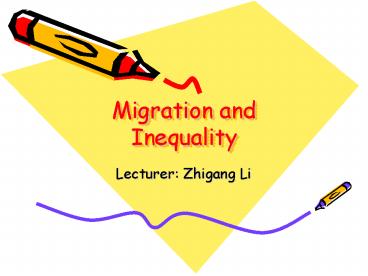Migration and Inequality - PowerPoint PPT Presentation
1 / 18
Title:
Migration and Inequality
Description:
Question: How does a change in Hukou status from rural to ... Immigrants who would be service, craft or elementary workers would fall. Empirical Findings II ... – PowerPoint PPT presentation
Number of Views:41
Avg rating:3.0/5.0
Title: Migration and Inequality
1
Migration and Inequality
- Lecturer Zhigang Li
2
Hukou and Inequality(Liu 2005)
- Question How does a change in Hukou status from
rural to urban affect a persons investment in
human capital and labor market performance? - Do people who obtain an urban hukou late in their
lives do worse than those who obtain urban hukou
earlier? - Answering the question may help us understand
- Urban-rural income differential
- Income differential between recent and early
hukou grantees.
3
The Hukou System
- The implementation of the hukou system is
supported by the ration system established in
1955. - Under the ration system, basic staples such as
grain, meat, cooking oil, sugar and cotton could
be bought only in state-run stores using ration
coupons. - Rural residents were excluded from the ration
system and were expected to be self-sufficient in
food. - Another important contributing factor to the
hukou system is the state control of urban
employment.
4
Hukou Reform
- Since 1990, the hukou system has become more
flexible. New types of residential registration
forms (administered by local governments) were
introduced - Temporary residential permit
- Blue-stamp hukou (blue card) Mainly issued to
investors, buyers of property, and professionals,
the blue-stamp hukou functions more like the
regular hukou. - A direct purchase of an urban hukou also became
possible in recent years. Between 1990 and 1994,
local government sold about 3 million hukou at an
average price of 8300 yuan a piece. - Rural hukou holders can now attend schools in
urban cities, but they need to pay fees and
tuitions substantially higher.
5
Data
- Chinese Household Income Project 1995
- All the urban individuals in the sample had urban
hukou in 1995, although they obtained it at
different ages. - Most of the individuals obtained urban resident
status within three years of birth. About 20
received urban hukou after 15 (middle school).
6
(No Transcript)
7
(No Transcript)
8
(No Transcript)
9
Findings
- The policy denies the rural population access to
quality education, resulting in lower educational
attainment by rural residents relative to their
urban counterparts. - The hukou system deprives the rural population
access to urban employment that rewards education
more than does rural employment. - By differentiating opportunity structures for
rural and urban population, the hukou system may
be a major cause of rural-urban disparity.
10
Impact of Removing Hukou(Whalley and Zhang, 2004)
- Method Calibrate an economic model to base case
data and then remove migration restrictions.
Inequality changes can then be calculated.
11
Experiment 1 Remove Migration Barrier
- Findings
- Significant migration from rural to urban
(200-600 million). - Rural wage increase. Urban wage fall. No
inequality in equilibrium. - Total output increase slightly.
12
Experiment 2 Allow for Within-Region Inequality
- Inequality decrease after the migration barriers
are abolished. - Significant inequality remains.
13
Experiment 3 Allow for Housing Prices to Change
- People migrate from poor to rich regions.
- The migration magnitude is relatively small
because housing prices increase in region with
migrants. - Inequality may increase in regions with migrants
due to increased housing prices.
14
Occupational Segregation between Natives and
Immigrants in Hong Kong (Liu et al., 2004)
- Hong Kong is a society of immigrants
- In 1996, 60 of HK workforce were native born.
About 33 are immigrants from mainland China. - Between 1898 and 1950, Chinese citizens could
freely enter and leave HK. - Between 1950 and 1979, strict rules were enforced
forbidding people migrating to HK, but people who
successfully reached HK will be allowed to stay. - After 1979, illegal migrants to HK were sent back.
15
Theory of Occupational Segregation
- Poor job matching for new immigrants
- Schooling of immigrants is not the same as
schooling of natives. - Discrimination against immigrants.
16
(No Transcript)
17
Empirical Findings I
- If the immigrants were to face the same
occupation structure as the natives - The proportions of immigrants who would be
managers/administrators, professionals and
associate professionals (about 5), clerks and
plant operators would increase - Immigrants who would be service, craft or
elementary workers would fall.
18
Empirical Findings II
- As the duration of residence rises from less than
5 years to more than 20 years, occupational
segregation declines from 22 to 5. - Occupational segregation is found to be
non-existent for immigrants who came to HK before
10 years old. For immigrants who came to HK when
they were over 20 years old, occupational
segregation is around 15 of wage differentials.































